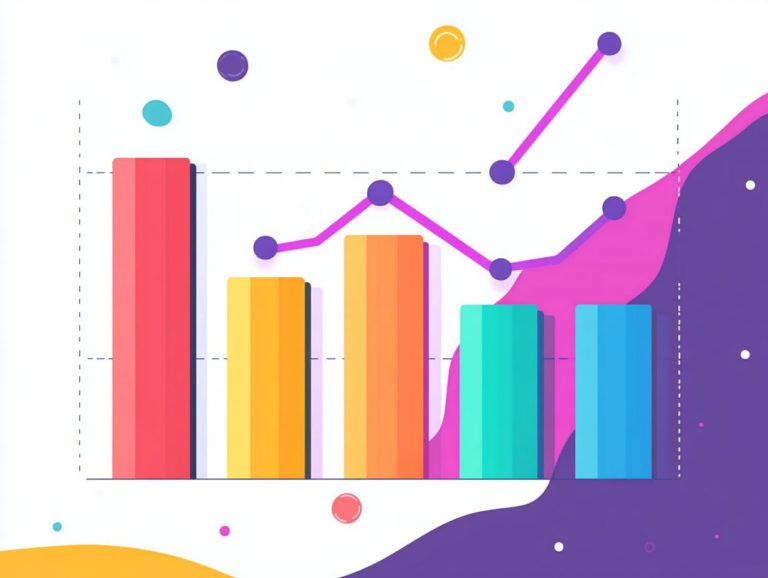Exploring B2B Demand Generation Strategies
Let's Set Up Your Lead Generation Strategy
Fill out the form below, and our team will get in touch with you to create a tailored solution for your business.
In today s competitive landscape, mastering B2B demand generation is essential for driving sales and facilitating sustainable growth. Don t miss out on the chance to grow your business!
This article unpacks the essence of demand generation, clearly defining its goals and spotlighting key components of a successful strategy. You’ll explore the importance of identifying target audiences and aligning sales and marketing efforts seamlessly.
You ll also delve into effective tactics such as inbound marketing and account-based marketing, learning how to measure success while implementing continuous optimization strategies.
Dive in to discover how your business can harness the power of demand generation to achieve measurable results.
Contents
- Key Takeaways:
- Understanding B2B Demand Generation
- Key Components of a Successful B2B Demand Generation Strategy
- Let's Set Up Your Lead Generation Strategy
- Content Marketing and Lead Nurturing
- Sales and Marketing Alignment
- Effective B2B Demand Generation Tactics
- Let's Set Up Your Lead Generation Strategy
- Measuring and Improving B2B Demand Generation
- Let's Set Up Your Lead Generation Strategy
- Frequently Asked Questions
- What is B2B demand generation?
- Why is exploring B2B demand generation strategies important?
- What are some effective B2B demand generation strategies?
- How can a company measure the success of their B2B demand generation strategies?
- What are some challenges companies may face when exploring B2B demand generation strategies?
- How can a company stay ahead of the changing B2B demand generation landscape?
Key Takeaways:

- Clearly defining B2B demand generation goals and understanding its key components are crucial for a successful strategy.
- Effective B2B demand generation tactics, such as inbound and account-based marketing, can help attract and convert high-quality leads.
- Measuring and continuously optimizing demand generation efforts based on tracked metrics is essential for long-term success.
Understanding B2B Demand Generation
B2B demand generation is a smart approach designed to attract and convert potential buyers into loyal customers, significantly boosting sales revenue, especially in the fiercely competitive SaaS market.
Understanding what your buyers need is key to attracting their attention. This process utilizes a blend of online and offline marketing tactics to cultivate awareness and interest in your product or service.
By aligning diverse marketing strategies with the specific needs of your target audience, you can effectively nurture leads and guide them seamlessly through the sales funnel. This approach not only drives higher conversion rates but also fosters enduring customer relationships that stand the test of time.
Definition and Goals
The primary goal of B2B demand generation is to generate excitement about what your company offers, leading to effective lead generation and, ultimately, increased sales revenue.
This process requires a strategic blend of marketing, sales, and customer engagement techniques tailored to attract your ideal audience. You might find success through content marketing, social media, and targeted campaigns that capture attention and cultivate relationships with potential clients.
A crucial aspect of demand generation involves nurturing these prospects with personalized communication and educational resources, transforming them from mere leads into loyal customers. By focusing on specific objectives like lead generation and fostering long-term relationships, you can establish a solid foundation for sustainable growth and success in the competitive B2B marketplace.
Key Components of a Successful B2B Demand Generation Strategy
A successful B2B demand generation strategy encompasses several key components, each vital in attracting and converting potential customers into loyal clients, particularly in the SaaS sector.
This requires a profound understanding of your target audience, ensuring that your marketing and sales teams are perfectly aligned in their efforts. Leverage compelling content marketing techniques to engage and nurture your leads effectively.
By integrating these elements, you can craft a robust framework that not only optimizes the buyer experience but also maximizes your sales revenue.
Target Audience Identification
Identifying your targeted audience is a foundational aspect of B2B demand generation, profoundly influencing the effectiveness of your marketing strategies and, ultimately, your sales revenue.
Let's Set Up Your Lead Generation Strategy
Fill out the form below, and our team will get in touch with you to create a tailored solution for your business.
Understanding this audience enables you to tailor your messaging, ensuring it resonates deeply with potential clients. To pinpoint the right groups, you should leverage analytics tools and customer data to glean insights into behaviors and preferences.
Creating detailed buyer personas are detailed descriptions of your ideal customers. Market segmentation means dividing your audience into smaller, more manageable groups. This will refine your targeting by illustrating the ideal customer based on demographics, pain points, and industry challenges.
Market segmentation further enhances this process, allowing you to divide the larger market into specific segments that can be nurtured with personalized content, thereby boosting engagement and conversion rates.
Content Marketing and Lead Nurturing

Content marketing and lead nurturing are essential for guiding potential customers through the sales funnel. You want to provide them with compelling content that directly addresses their needs and pain points.
By crafting valuable and relevant content tailored to each stage of the buying journey, you can engage prospects on a deeper level. For example, informative blog posts are short articles that provide insights, while whitepapers are detailed reports on specific topics that dive into complex subjects, showcasing your expertise and offering insights that resonate with decision-makers.
Case studies illustrate real-world applications of your solutions, fostering trust and credibility. Together, these content types not only educate potential customers but also facilitate ongoing conversations, nurturing relationships that pave the way for conversions and long-term loyalty.
Sales and Marketing Alignment
Sales and marketing alignment is crucial in B2B demand generation, ensuring that both teams are united in their goals. This collaboration improves the customer experience and drives sales revenue.
When these two departments work together effectively, they can craft a seamless customer journey that attracts qualified leads and converts them into loyal clients. Improved communication fosters a deeper understanding of customer needs, allowing for marketing strategies that truly resonate with your target audience.
To achieve this alignment, consider implementing the following:
- Regular joint meetings
- Sharing performance metrics
- Utilizing integrated technology platforms that support shared objectives
The positive effects on lead quality and conversion rates can significantly boost your company’s bottom line while nurturing lasting relationships with customers.
Effective B2B Demand Generation Tactics
To truly excel in B2B demand generation, implement effective tactics immediately to resonate with your targeted audience. This means focusing on a blend of inbound and account-based marketing strategies that capture attention and drive engagement.
Inbound Marketing
Inbound marketing serves as a potent strategy for B2B demand generation, designed to draw in potential customers through valuable content and online tactics. This approach transforms the conventional mindset from disruptive techniques to building a better, helpful relationship with your audience.
Create content that truly connects with your audience s needs. The core principles include:
- Understanding the buyer’s journey
- Leveraging SEO for increased visibility
- Utilizing social media to build community and engagement
Effective strategies often involve tailoring your messages to specific audience segments and analyzing performance metrics to refine your campaigns. This interconnected framework not only enhances brand loyalty but also improves lead quality, setting the stage for sustainable growth.
Let's Set Up Your Lead Generation Strategy
Fill out the form below, and our team will get in touch with you to create a tailored solution for your business.
Account-Based Marketing
Account-based marketing (ABM), a strategy that focuses on targeted accounts, is your strategic ace in the B2B demand generation game. It allows you to zero in on specific accounts to enhance engagement and boost sales revenue.
This method transforms your interactions, making them more impactful and personal! It channels your efforts toward high-value accounts instead of taking a broad-brush approach. In the often lengthy and complex landscape of B2B sales cycles, this targeted strategy gives you the power to tailor your messaging and content specifically for the key players within those accounts.
Identifying these accounts demands a keen eye and sophisticated techniques, such as data analysis and market research, which help you pinpoint the industries, company sizes, and specific roles that are most likely to benefit from your solutions.
Crafting personalized content that speaks directly to the unique challenges and goals of these targeted accounts ensures that your engagement efforts are not only more compelling but also markedly more effective ultimately leading to higher conversion rates and stronger customer relationships.
Start targeting your key accounts today for better engagement and results!
Events and Webinars

Hosting events and webinars is a powerful B2B demand generation tactic. These initiatives amplify market awareness and engage potential customers with insightful sessions.
These interactive platforms allow you to showcase your expertise and create meaningful connections with your audience. By delivering valuable content that addresses the specific challenges faced by your prospects, you can cultivate trust and establish yourself as a thought leader in your industry.
As you plan these initiatives, make sure you set clear goals and target the right audience. Choose engaging formats that keep attendees invested. Don t overlook the importance of integrating follow-up strategies; personalized thank-you emails and post-event surveys can significantly enhance your relationship-building and lead nurturing efforts.
Measuring and Improving B2B Demand Generation
Measuring and enhancing B2B demand generation requires you to analyze key metrics carefully. Implement ongoing optimization strategies to boost performance and drive substantial sales revenue.
Metrics to Track
When measuring your B2B demand generation efforts, tracking specific metrics related to lead generation and sales revenue is essential to understand performance.
By closely monitoring your conversion rates, you can see how effectively leads are nurtured through the sales funnel, directly impacting your revenue outcomes. Evaluating customer acquisition costs gives you insights into the efficiency of your marketing campaigns, helping you refine your strategies.
Focusing on lead quality ensures that you pursue the most promising prospects, ultimately boosting your overall effectiveness. These metrics reveal the strengths and weaknesses of your demand generation tactics, guiding you toward informed choices for better results in the future.
Continuous Optimization Strategies
Implementing continuous optimization strategies in B2B demand generation is crucial for enhancing performance and maximizing sales revenue over time.
Consider methods like A/B testing, which means comparing two versions of your marketing materials to see which one works better. Gathering user feedback is also vital; it provides insights into customer preferences and pain points, enabling targeted adjustments that resonate with your audience.
Let's Set Up Your Lead Generation Strategy
Fill out the form below, and our team will get in touch with you to create a tailored solution for your business.
By making iterative improvements to your marketing strategies, you keep your approach fresh and aligned with ever-changing market dynamics. Regularly adapting to shifts in customer behavior allows you to create a more responsive demand generation process, driving better engagement and higher conversion rates.
Frequently Asked Questions
What is B2B demand generation?

B2B demand generation is the process of identifying, attracting, and engaging potential customers for a business-to-business (B2B) company. It involves strategic marketing and sales tactics to create demand for a company’s products or services.
Why is exploring B2B demand generation strategies important?
Exploring B2B demand generation strategies helps companies generate more leads, increase sales, and grow their business. It allows them to target the right audience and build a strong pipeline of potential customers.
What are some effective B2B demand generation strategies?
Effective B2B demand generation strategies include content marketing, email marketing, social media marketing, SEO, webinars, and events. These tactics attract and engage potential customers at different stages of the sales funnel.
Act now to enhance your demand generation efforts! Consider signing up for our upcoming webinars or downloading our resources for further insights.
How can a company measure the success of their B2B demand generation strategies?
Companies can measure the success of their B2B demand generation by tracking important metrics like website traffic and lead conversion rates. Sales revenue and customer retention are also crucial indicators to consider.
They can use marketing automation tools to monitor and analyze the results of their campaigns effectively.
What are some challenges companies may face when exploring B2B demand generation strategies?
Companies often struggle to identify the right target audience. Creating compelling content and choosing effective channels to reach potential customers can also be challenging.
Budget constraints and market competition can make it tough to stand out from the crowd.
How can a company stay ahead of the changing B2B demand generation landscape?
To stay ahead, companies need to continuously review and adapt their strategies based on market trends and customer behavior. Investing in new technologies and tools will improve their processes and give them a competitive edge.






